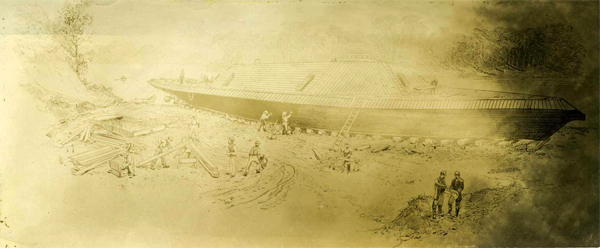20 Jan. 1829–14 Oct. 1905
Peter Evans Smith, inventor, the eldest son of William R., Jr., and Susan Evans Smith, was born at the Edgecombe plantation of his maternal grandfather, Peter Evans. He received his early education at the Vine Hill Academy in Scotland Neck and was prepared for college at the Bingham School. Smith was graduated from The University of North Carolina in 1851. In 1852 he married Rebecca Norfleet Hill of Scotland Neck, and his father gave him a plantation on the Roanoke to farm. Possessing a natural mechanical bent, he was never fond of farming, and the outbreak of the Civil War a few years later gave him his opportunity.
Early in the war Smith was a quartermaster officer in the Confederate army, on detached duty because of premature deafness. In 1863 the Confederate government conceived the idea of building a gunboat on the Roanoke River to aid in the recapture of Plymouth at the river's mouth. Gilbert Elliott, then only nineteen, secured the contract and arranged the financing. The plans were drawn up by John L. Porter, of Norfolk, a famous naval architect, and the responsibility for the construction was assigned to Peter Smith. The site for construction of the gunboat was in a gut in the river's edge on his father's Edwards Ferry plantation. Working against incredible odds and using only the resources available in the neighborhood, the boat was finished in a year's time. One problem encountered was in attaching the iron plates of the superstructure to the wooden hull. The drills then available took twenty minutes to bore through the armor, which was an inch and a quarter thick. Smith invented the now familiar twist drill that only took four minutes.

The Albemarle, as the ram was christened, had a brief period of glory in the spring of 1864, when she sank several Federal warships in Albemarle Sound and enabled the Confederate army under Robert F. Hoke to recapture Plymouth. She was torpedoed by a young Federal naval officer, Lieutenant William B. Cushing, while tied up at the wharf at Plymouth. A New York Times article of 7 June 1936 on Cushing described the Albemarle at the time of her destruction as "the most powerful warship in the world." She was the only ironclad when all the other ships were still of wood.
With the end of the war Smith turned his inventive talents to peaceful pursuits. In 1871 he invented a cotton planter that was superseded by later models because, in his design, the seed had to be wet. A sulky plow followed in 1871. His most significant invention was a buoy lighted by electricity. Patented in the United States and England, these buoys were used to light New York harbor six years before the patent expired. As Smith had been paid nothing for the use of his patent, he brought suit against the government in federal court. The case reached the Supreme Court with a verdict in the government's favor. His later inventions were a spark arrester for the smokestack of the wood-burning locomotives, then in use, patented in 1885; a self-coupling device for railroad coaches; and a form of railroad switch.
As Scotland Neck was twenty miles from the nearest railroad, he offered his services free of charge to the Wilmington and Weldon to survey a road from Halifax as an incentive to the company to build a branch line. The line was completed in 1880. The railroad later hired Smith to carry the line from Scotland Neck to Kinston, Washington, N.C., and other eastern points.
He died at his home in Scotland Neck. By his wife Rebecca, the daughter of Whitmel John Hill of Scotland Neck, he had three daughters who reached maturity: Lena, Rebecca, and Nan.